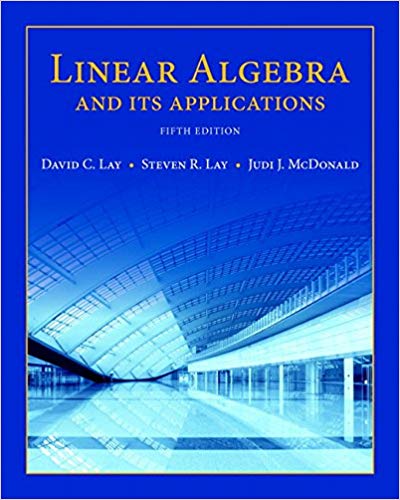
Linear Algebra and Its Applications, 5th Edition
Authors: David C. Lay, Steven R. Lay, Judi J. McDonald
ISBN-13: 978-0321982384
We have solutions for your book!
See our solution for Question 25E from Chapter 8.4 from Lay's Linear Algebra and Its Applications, 5th Edition.
Problem 25E
Chapter:
Problem:
0
Step-by-Step Solution
Given Information
Given that $\mathbf { p } = \left[ \begin{array} { l } { 4 } \\ { 1 } \end{array} \right] .$ We have to find a hyperplane $[ f : d ]$ that strictly separates $B ( \mathbf { 0 } , 3 )$ and $B ( \mathbf { p } , 1 )$ .
Step-1:
Length of line joining $B ( \mathbf { 0 } , 3 )$ and $B ( \mathbf { p } , 1 )$\[\begin{aligned} L & \approx \left( 4 ^ { 2 } + 1 ^ { 2 } \right) ^ { \dfrac { 1 } { 2 } } \\ & \approx 4.1231 \end{aligned}\]
Step-2:
A hyperplane whose normal vector is p can be found as:\[f ( \mathbf { x } ) = \mathbf { p } \cdot \mathbf { x }\]Find a point on the line L. \[\begin{aligned} \mathbf { q } & = ( 0.25 ) \mathbf { 0 } + ( 0.75 ) \mathbf { p } \\ & = 3.75 \end{aligned}\]Evaluate $f$ at above point to find the value of d:\[\begin{aligned} d & = \mathbf { p } \cdot \mathbf { q } \\ & = ( 4 ) ( 3 ) + 1 ( 0.75 ) \\ & = 12.75 \end{aligned}\]
$f ( \mathbf { x } ) = \mathbf { p } \cdot \mathbf { x }$ and $d=12.75$
Given that $\mathbf { p } = \left[ \begin{array} { l } { 4 } \\ { 1 } \end{array} \right] .$ We have to find a hyperplane $[ f : d ]$ that strictly separates $B ( \mathbf { 0 } , 3 )$ and $B ( \mathbf { p } , 1 )$ .
Step-1:
Length of line joining $B ( \mathbf { 0 } , 3 )$ and $B ( \mathbf { p } , 1 )$\[\begin{aligned} L & \approx \left( 4 ^ { 2 } + 1 ^ { 2 } \right) ^ { \dfrac { 1 } { 2 } } \\ & \approx 4.1231 \end{aligned}\]
Step-2:
A hyperplane whose normal vector is p can be found as:\[f ( \mathbf { x } ) = \mathbf { p } \cdot \mathbf { x }\]Find a point on the line L. \[\begin{aligned} \mathbf { q } & = ( 0.25 ) \mathbf { 0 } + ( 0.75 ) \mathbf { p } \\ & = 3.75 \end{aligned}\]Evaluate $f$ at above point to find the value of d:\[\begin{aligned} d & = \mathbf { p } \cdot \mathbf { q } \\ & = ( 4 ) ( 3 ) + 1 ( 0.75 ) \\ & = 12.75 \end{aligned}\]
$f ( \mathbf { x } ) = \mathbf { p } \cdot \mathbf { x }$ and $d=12.75$